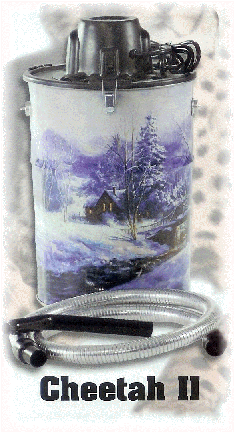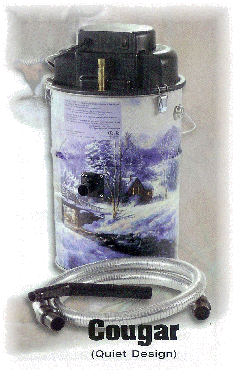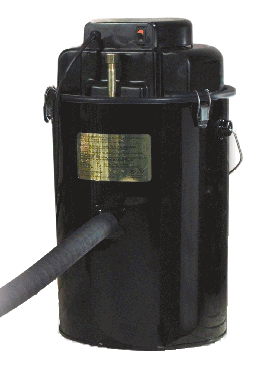Love-Less Ash Vac

These vacuums are specifically designed to remove warm to cold ash from wood stoves, pellet stoves, fireplaces and barbecues. There is a definite, simple technique to use for best results. Available in Black, Green, or Winter Scene.
- Patented double filter system
- Comes complete with a FIRE RETARDANT PRIMARY FILTER.
- Cleaning rod and pliable filters allow cleaning without removing the lid.
- 5 ft. FLAME RETARDANT HOSE allows ash to pass through the hose to the canister without damage to the hose.
- Designed for conventional stoves and fireplaces as well as pellet and grain burning stoves.
Cheetah Model MU305

Cougar Model MU405 - The Quiet One!
If you have ever tried to vacuum out your ashes with a vacuum cleaner only to turn around when you are done to see a cloud of ash hovering around your head then you have come to the right spot. The Cougar MU405 is the Cadillac of Ash Vacuums with its quiet design and powerful motor; this is the vacuum of choice.
 
Frequently Asked Questions
The nozzle gets clogged up and I can’t take out the ash. Or- I have to use my fingers to get the ash off the nozzle. Why?
The crimped end of the nozzle must be put directly onto the fire chamber of the conventional stove or fireplace and moved it back and forth or in a circular motion. This cleans a small area and then the nozzle is moved from the cleaned area to the ash surrounding it.
The ash is actually removed from the bottom and not the top. This helps the ash to move quickly along the hose and keeps the nozzle opening free and clear of debris. As the ash is being taken into the vacuum, larger pieces can be moved out of the way removed at a later time.
Customers should never have to use their hands or fingers to remove particles stuck on the end of the nozzle. This vacuum will only allow fine ash to travel through the nozzle and hose. Larger particles or materials are not meant to be removed with this vacuum.
Why can’t I take out large pieces?
The vacuum is designed to remove only ash.
Why is the hose so stiff?
The hose is a bit unwieldy because it is made to handle the possibility of warm coals and embers. It is flame retardant. It should be positioned so that the hose has a natural curve from the vacuum to the nozzle that is put inside of the stove or fireplace. The customer should not position the vacuum so that a kink forms in the hose or else it will cut off the suction. The motor is cooled by external air so if the nozzle does become clogged, it will not damage the motor.
I don’t have any suction.
Usually, the reason for poor suction is that the vacuum has been used and a crust of ash has formed on the outside of the primary filter and it cannot breathe properly. The customer assumes that the vacuum is then not working.
Cleaning procedure for filters.
Remove the brass nipple and cap from the top of the lid and then raise the metal rod or "NOGGLE" approximately ½ inch and rock it from side to side so that the ash that has collected on the outside of the primary filter can be shaken off and suction will resume as before.
The nipple and cap must be screwed back into place, just finger tight. The vacuum needs to be maintained so the nipple and cap must be in place, when in operation.
If the customer has used the vacuum extensively and loses suction, the reason is usually that the secondary filter has become coated with very fine ash, to the point that it needs to be cleaned. This will usually happen after 60-80 gallons of ash has been collected by the vacuum.
To clean the secondary filter, the primary filter needs to be taken off and the secondary filter needs to be vacuumed off by another vacuum source, usually a home/ shop vacuum. If there is any residual ash caught inside the two filters, this is a good time to take that out as well. The filters are held on by hose clamps that only require a flat blade screwdriver.
The Cheetah II is designed with the small cage part of the lid mounted on snap springs so when the vacuum is turned on the basket will rest against the cage and compress the springs. When the vacuum is turned off the springs snap back and clean the secondary filter without the customer ever being aware of it. This is why the customer can use it for such a great length of time without even needing to look at the secondary filter. This new design is extremely user friendly.
Can I wash the filters?
No. Both filters are specially coated and if they are washed, the finish will be removed and they will not operate properly.
There are holes in my primary filter, what are they from?
The customer has vacuumed up HOT COALS and/or LIVE EMBERS. If ashes are not totally dead, the forced air from the vacuum will re-ignite them and they could come to rest against the side of the primary filter and scorch a hole through it. If unburned fines are removed from and they coat the primary filter and then live ash is pulled through the vacuum and it happens to come to rest against the filter, it will set the fines on fire and a large area of the filter will be scorched.
Can I use this vacuum for other things?
No. This vacuum is only designed for ash. If it is used as a regular shop vacuum for materials that could be flammable and then used in a stove and live embers are removed, a fire could result.
How often should I change the filters?
Changing of the filters is determined by the use and care that are given. We recommend that the filters be changed after about 100 gallons of ash have gone through the vacuum.
How full can I fill the vacuum?
We recommend emptying the vacuum when the ash level is as high as the port on the side of the canister. When the ash gets this high, the customer will usually notice a slight reduction in suction because of the reduced area for depositing the ash in the canister.
Can I take out HOT COALS?
No. We recommend cool ash removal as a safety factor to the customer. The word HOT – usually lends the customer to believe that the vacuum is indestructible and it does have limitations as to how much heat and especially the amount of burning materials that can be taken out of a stove. The customer needs to exercise good common sense in this decision.
Owners Manual
Click here to view the owners manual
www.lovelessash.com
*Prairie Fire Grain Energy Inc. has obtained all information from Love-Less Ash Company with permission. |